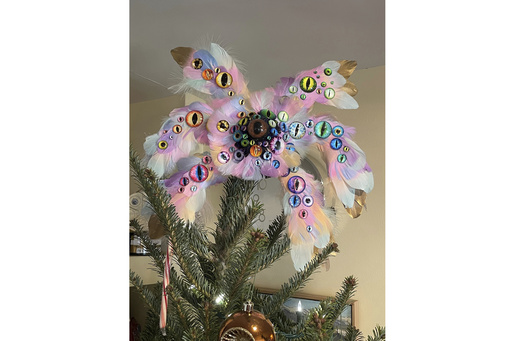
NASHVILLE, Tenn. — During the pandemic, Rev. Kira Austin-Young and her husband, puppet-maker Michael Schupbach, found themselves in a creative rut that sparked a unique idea. Instead of the typical star or a conventional angel to adorn their Christmas tree, they opted for a biblically inspired angel. The outcome was an eye-catching entity, adorned in pink, blue, and gold feathers, featuring six wings and numerous eyes, which quickly gained popularity on social media.
Rev. Austin-Young, who serves as the associate rector of the Episcopal Church of St. Mary the Virgin in San Francisco, emphasized the relevance of such a “scary and weird” angel in today’s unpredictable world. She noted that the Bible describes various types of angels, particularly in the prophetic books of the Old Testament and the Book of Revelation, where readers encounter bizarre creatures surrounding God’s throne.
“Some have six wings covered in eyes,” she explained, while others possess multiple animal heads. Austin-Young finds joy in the eccentric and surreal aspects of scripture, suggesting that these elements make the text engaging and thought-provoking. A recent poll showed that approximately 70% of American adults believe in angels. However, there seems to be little consensus regarding their appearances or true nature.
The internet is awash with diverse interpretations of “biblically accurate angels,” manifesting not only in festive tree toppers but also in art, tattoos, and beauty tutorials. These unique portrayals starkly contrast the traditional Western depictions of angels, which often present them as ethereal, human-like beings adorned with large, white wings.
Esther Hamori, a Hebrew Bible professor at Union Theological Seminary, acknowledges the distinction between angels and other biblical entities such as seraphim and cherubim. Nevertheless, she appreciates the growing trend of accurately representing biblical angels and believes it encourages deeper reflection on the Bible’s richer, often stranger meanings.
“The biblical heavens are filled with weird, frightening figures,” Hamori noted, explaining that the image of God is often accompanied by a retinue of extraordinary beings. One cherished representation of the announcement to Mary, depicting the archangel Gabriel proclaiming her divine motherhood, comes from artist Henry Ossawa Tanner. In his work, Gabriel is conceptualized as a beam of light, challenging traditional representations and inviting viewers to reconsider the nature of angelic encounters.
“Imagine what it would be like to be visited by an angel,” Austin-Young posited. “It could be an unfamiliar being, a curious creature, or even simply a manifestation of God conveying a message. The possibilities are boundless.”
